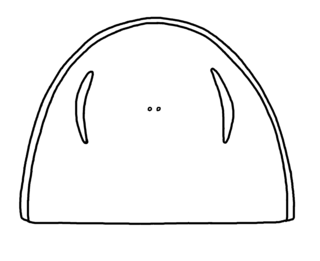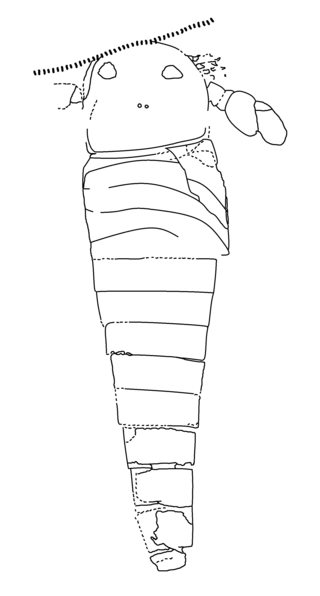
Eurypterids, often informally called sea scorpions, are a group of extinct arthropods that form the order Eurypterida. The earliest known eurypterids date to the Darriwilian stage of the Ordovician period 467.3 million years ago. The group is likely to have appeared first either during the Early Ordovician or Late Cambrian period. With approximately 250 species, the Eurypterida is the most diverse Paleozoic chelicerate order. Following their appearance during the Ordovician, eurypterids became major components of marine faunas during the Silurian, from which the majority of eurypterid species have been described. The Silurian genus Eurypterus accounts for more than 90% of all known eurypterid specimens. Though the group continued to diversify during the subsequent Devonian period, the eurypterids were heavily affected by the Late Devonian extinction event. They declined in numbers and diversity until becoming extinct during the Permian–Triassic extinction event 251.9 million years ago.

Hughmilleria is a genus of eurypterid, an extinct group of aquatic arthropods. Fossils of Hughmilleria have been discovered in deposits of the Silurian age in China and the United States. Classified as part of the basal family Hughmilleriidae, the genus contains three species, H. shawangunk from the eastern United States, H. socialis from Pittsford, New York, and H. wangi from Hunan, China. The genus is named in honor of the Scottish geologist Hugh Miller.

Chasmataspidids, sometime referred to as chasmataspids, are a group of extinct chelicerate arthropods that form the order Chasmataspidida. Chasmataspidids are probably related to horseshoe crabs (Xiphosura) and/or sea scorpions (Eurypterida), with more recent studies suggest that they form a clade (Dekatriata) with Eurypterida and Arachnida. Chasmataspidids are known sporadically in the fossil record through to the mid-Devonian, with possible evidence suggesting that they were also present during the late Cambrian. Chasmataspidids are most easily recognised by having an opisthosoma divided into a wide forepart (preabdomen) and a narrow hind part (postabdomen) each comprising 4 and 9 segments respectively. There is some debate about whether they form a natural group.

Jaekelopterus is a genus of predatory eurypterid, a group of extinct aquatic arthropods. Fossils of Jaekelopterus have been discovered in deposits of Early Devonian age, from the Pragian and Emsian stages. There are two known species: the type species J. rhenaniae from brackish to fresh water strata in the Rhineland, and J. howelli from estuarine strata in Wyoming. The generic name combines the name of German paleontologist Otto Jaekel, who described the type species, and the Greek word πτερόν (pteron) meaning "wing".

Alkenopterus is a genus of prehistoric eurypterid classified as part of the family Onychopterellidae. The genus contains two species, A. brevitelson and A. burglahrensis, both from the Devonian of Germany.

Bassipterus is a genus of eurypterid, an extinct group of aquatic arthropods. Bassipterus is classified as part of the family Adelophthalmidae, the only clade within the derived ("advanced") Adelophthalmoidea superfamily of eurypterids. Fossils of the single and type species, B. virgnicus, have been discovered in deposits of the Late Silurian age in West Virginia and Maryland, United States. The genus is named after Bass, where most of the fossils have been recovered.

Nanahughmilleria is a genus of eurypterid, an extinct group of aquatic arthropods. Fossils of Nanahughmilleria have been discovered in deposits of Devonian and Silurian age in the United States, Norway, Russia, England and Scotland, and have been referred to several different species.

Onychopterella is a genus of predatory eurypterid, an extinct group of aquatic arthropods. Fossils of Onychopterella have been discovered in deposits from the Late Ordovician to the Late Silurian. The genus contains three species: O. kokomoensis, the type species, from the Early Pridoli epoch of Indiana; O. pumilus, from the Early Llandovery epoch of Illinois, both from the United States; and O. augusti, from the Late Hirnantian to Early Rhuddanian stages of South Africa.

Willwerathia is a genus of Devonian arthropod. It is sometimes classified as synziphosurine, a paraphyletic group of horseshoe crab-like fossil chelicerate arthropods, while some studies compare its morphology to an artiopod. Willwerathia known only by one species, Willwerathia laticeps, discovered in deposits of the Devonian period from the Klerf Formation, in the Rhenish Slate Mountains of Germany.

Pittsfordipterus is a genus of eurypterid, an extinct group of aquatic arthropods. Pittsfordipterus is classified as part of the family Adelophthalmidae, the only clade in the derived ("advanced") Adelophthalmoidea superfamily of eurypterids. Fossils of the single and type species, P. phelpsae, have been discovered in deposits of Silurian age in Pittsford, New York state. The genus is named after Pittsford, where the two only known specimens have been found.

Parahughmilleria is a genus of eurypterid, an extinct group of aquatic arthropods. Fossils of Parahughmilleria have been discovered in deposits of the Devonian and Silurian age in the United States, Canada, Russia, Germany, Luxembourg and Great Britain, and have been referred to several different species. The first fossils of Parahughmilleria, discovered in the Shawangunk Mountains in 1907, were initially assigned to Eurypterus. It would not be until 54 years later when Parahughmilleria would be described.

Adelophthalmus is a genus of eurypterid, an extinct group of aquatic arthropods. Fossils of Adelophthalmus have been discovered in deposits ranging in age from the Early Devonian to the Early Permian, which makes it the longest lived of all known eurypterid genera, with a total temporal range of over 120 million years. Adelopththalmus was the final genus of the Eurypterina suborder of eurypterids and consisted the only known genus of swimming eurypterids from the Middle Devonian until its extinction during the Permian, after which the few surviving eurypterids were all walking forms of the suborder Stylonurina.

The Klerf Formation is an Early Devonian (Emsian) formation that includes a Lagerstätte in the Northern Eifel hills, at Willwerath near Prüm, Rhineland-Palatinate, Germany. In it Jaekelopterus rhenaniae, a giant eurypterid was discovered. The Klerf Formation, comprising greenish and reddish shales, siltstones and sandstones, was first described in 1919 by Rudolf Richter (1881-1957) and reaches a maximum thickness of about 1,300 metres (4,300 ft). It is part of Alken quarry along with Nellenköpfchen Formation.

Unionopterus is a genus of eurypterid, an extinct group of aquatic arthropods commonly known as "sea scorpions". Fossils have been registered from the Early Carboniferous period. The genus contains only one species, U. anastasiae, recovered from deposits of Tournaisian to Viséan stages in Kazakhstan. Known from one single specimen which was described in a publication of Russian language with poor illustrations, Unionopterus' affinities are extremely poorly known.

Adelophthalmidae is a family of eurypterids, an extinct group of aquatic arthropods. Adelophthalmidae is the only family classified as part of the superfamily Adelophthalmoidea, which in turn is classified within the infraorder Diploperculata in the suborder Eurypterina.

Hughmilleriidae is a family of eurypterids, an extinct group of aquatic arthropods. The hughmilleriids were the most basal members of the superfamily Pterygotioidea, in contrast with the more derived families Pterygotidae and Slimonidae. Despite their classification as pterygotioids, the hughmilleriids possessed several characteristics shared with other eurypterid groups, such as the lanceolate telson.

Wiedopterus is a genus of eurypterid, an extinct group of aquatic arthropods. The type and only species of Wiedopterus, W. noctua, is known from deposits of Early Devonian age in Germany. The generic name derives from the Wied river, which runs near the site of the initial discovery, and the species name, noctua, derives from Latin noctua (owl) which refers to the superficial resemblance of the carapace to an owl.

Eysyslopterus is a genus of eurypterid, an extinct group of aquatic arthropods. Eysyslopterus is classified as part of the family Adelophthalmidae, the only clade within the derived ("advanced") Adelophthalmoidea superfamily of eurypterids. One fossil of the single and type species, E. patteni, has been discovered in deposits of the Late Silurian period in Saaremaa, Estonia. The genus is named after Eysysla, the Viking name for Saaremaa, and opterus, a traditional suffix for the eurypterid genera, meaning "wing". The species name honors William Patten, an American biologist and zoologist who discovered the only known fossil of Eysyslopterus.

Borchgrevinkium is an extinct genus of chelicerate arthropod. A fossil of the single and type species, B. taimyrensis, has been discovered in deposits of the Early Devonian period in the Krasnoyarsk Krai, Siberia, Russia. The name of the genus honors Carsten Borchgrevink, an Anglo-Norwegian explorer who participated in many expeditions to Antarctica. Borchgrevinkium represents a poorly known genus whose affinities are uncertain.

Dvulikiaspis is a genus of chasmataspidid, a group of extinct aquatic arthropods. Fossils of the single and type species, D. menneri, have been discovered in deposits of the Early Devonian period in the Krasnoyarsk Krai, Siberia, Russia. The name of the genus is composed by the Russian word двуликий (dvulikij), meaning "two-faced", and the Ancient Greek word ἀσπίς (aspis), meaning "shield". The species name honors the discoverer of the holotype of Dvulikiaspis, Vladimir Vasilyevich Menner.



















